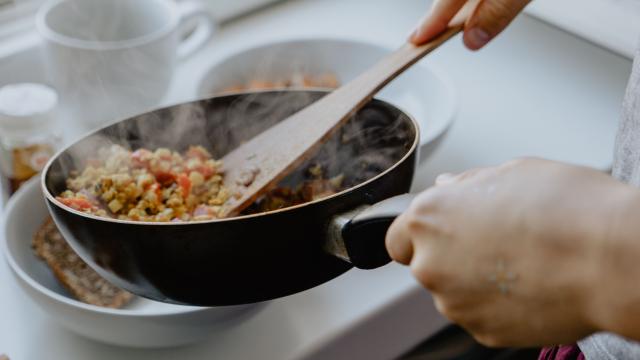If you are one to get caught up in details and definitions, cooking from recipes can kick the pedantic portion of your brain into overdrive. Words and phrases that are intuitive to more seasoned home cooks can prove utterly mystifying to newbies, particularly those related to the construct that is time.
Even I, a person whomst cooks, has a hard time with phrases such as “stir frequently,” because the definition of “frequently” can vary wildly, depending on the context. I have been told I send memes “too frequently,” but if I were to stir a pan of sizzling vegetables at the rate I send memes, they would burn (just like my hot memes).
As with sending memes, it is important to know your goal when stirring. There are a few reasons you stir food: to keep it moving in the pan, promoting even cooking and preventing burning (think scrambled eggs and stir fries) to emulsify ingredients into one homogenous, smooth liquid (as in sauces and gravies); and to combine ingredients, and create uniform flavour dispersal. Some people also stir to alleviate their anxiety, or feel like they’re contributing in the kitchen, but these are not necessary, and may be counter-productive in some cases.
Understanding why a recipe is telling you to stir is far more helpful than counting the minutes between spoon rotations. The easiest direction to understand is “stir constantly,” which means exactly what it says. You need to keep that food moving for as long as the recipe demands it, usually in order to emulsify or prevent the food from burning or sticking to the bottom of the pan or pot. This is particularly true when thickening a liquid with starch (like you would with gravy or custard) or with anything that contains a lot of dairy (it could scorch).
“Stir frequently” and “stir occasionally,” are a little more vague, but clues can be gleaned from the rest of the recipe, the temperature you’re using, and what you want the final product to look and taste like. Think of an onion: do you want charred edges with some browning, but want to preserve a bit of bite and texture? You’ll want to stir every few couple of minutes over medium-high heat or even more frequently over higher heat.
Do you want a soft, caramelised onion that’s practically melting? Leave it alone to cook over low heat, only stirring as much as you have to to make sure everyone is getting the same amount of heat and that no one is burning (this is particularly important if you have shitty, uneven burners).
Trying to reduce a soup or sauce? You’ll want to stir even less—just to make sure nothing is getting stuck on the bottom and scrape the sides of the pot — since stirring releases heat, and heat is what you need to drive off excess water. One thing you don’t want to stir? Anything being deep fried — just let the hot oil do it’s thing, and remove once you have that crispy crust.
Another way to think of it is in terms of where I need to physically be in relation to the food. If I’m stir frying a pan of vegetables over high heat or scrambling some eggs, I need to be right there, keeping an eye on things and stirring frequently, maybe checking Twitter in between stirs.
But if I’m cooking a stew or or rendering and browning some sausage, I have more freedom. I can wash a few dishes, make a cocktail, or go see what my cat knocked over in the other room, returning to stir occasionally .
The most important thing to remember is that cooking is not done in a vacuum. Pots, pans, and stoves vary more than you might think from kitchen to kitchen, and you have to use your eyes, ears, and nose. If you are stirring “occasionally” but your nose tells you something is getting a little too cooked, stir a little more, or turn down the heat.
If you have been cooking something for the prescribed amount of time, yet it doesn’t have the colour you want, slow down and let the food hang out in the pan, unmolested, for a bit more time. Finally, remember to relax. The worst thing that will happen is a little sticking or a little burning, and none of that is a great tragedy.

Comments